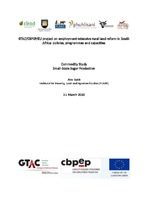| dc.description.abstract | The South African sugar industry has long been one of South Africa’s most substantial agro-industries. The South African Sugar Association (SASA) estimates that around R16bn in value is annually created by 85,000 directly employed and 350,000 indirectly employed persons, and ultimately with approximately one million rural lives dependant on these jobs. Every 1,000 hectares (ha) in sugarcane land, the industry estimates, carries an average of 133 permanent and 210 seasonal jobs (SASA 2019; SASA 2019 pers. comm.).1 2
In addition to its sheer magnitude, the sugar industry is distinct from other agro-industries by the inclusion in the 1970s of substantial numbers of black small-scale sugarcane growers (SSGs), farming predominately under ‘communal’ or ‘customary’ tenure. The inclusion of small-scale black growers in a ‘formal’ value chain has been variously attributed to systems of rotating credit (SASYB 1974/5), the command of land resources by traditional authorities and of production processes by miller sugar producers (Vaughan 1992a, Vaughan 1991), and opportunities to accumulate by ‘contractors’ providing planting, harvest and haulage services (Vaughan 1992b, Munro 1996). | en_US |

